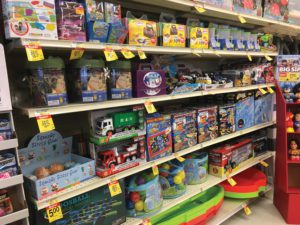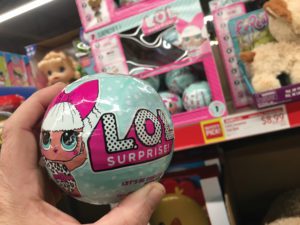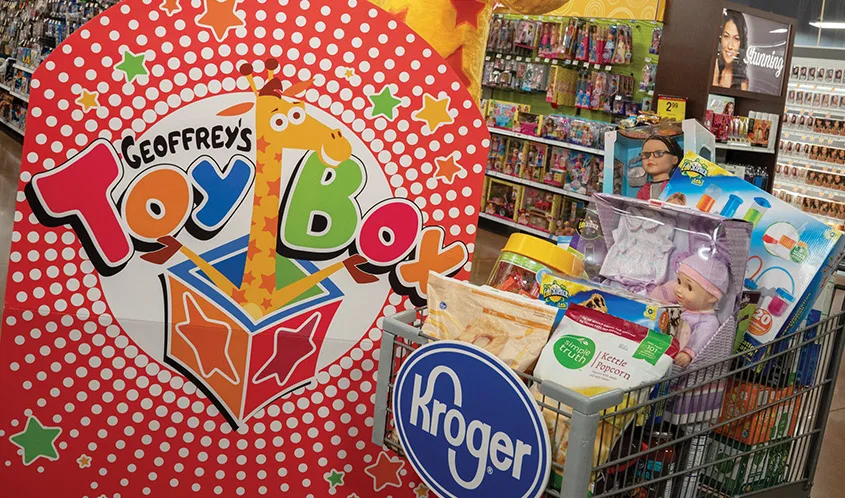With billions in potential sales up for grabs, grocery retailers are ready to play again.
Retail trends tend to come in waves, crashing in hard and quickly receding just before the next tide rolls in—they ebb and flow, if you will. When it comes to the relationship between toys and grocers, seasonality traditionally dictates the business, but that’s something that’s starting to change. Following a retreat for a few years, an increasing amount of grocery retailers are dedicating more space to toys, and the wave that drove the boom last year was the collapse of Toys “R” Us. With that behind us, this year is an opportunity to look at how toys can have a bigger presence at grocery year-round with the right mix between trendy and timeless.
KNOCKING THE DUST OFF
Placing an assortment of toys directly within or adjacent to greeting cards and party goods is an old standard, but one worthy of a fresh look. We are familiar with the occasional 4- to 8-foot section of sad, dusty old stock, and that’s a thing that should never be. You wouldn’t keep perishables on the shelf past their expiration date, and you shouldn’t stock shop-worn toys. If you look at what Party City does to maintain an assortment of the right toys for gifting, the same idea can easily apply on a smaller scale for grocery. Display and assortment are key.

CURATING FRESHNESS
“I personally think Wegman’s has done a nice job over the last few years to curate a selection of quality toys in its stores. Things that are both appealing to consumers and that are at great price points make sense from a retailer perspective (profit potential). There is opportunity for toys in grocery, especially to capture impulse, party, and special occasion purchases. Grocery won’t be a toy shopping destination per se,” Steve Pasierb, president and CEO of The Toy Association, says.
On-trend displays of pocket money toys, especially small collectibles and blind packs, need to drive the impulse purchases. Keep the assortment fresh, and keep it moving by staying on top of what’s hot, but also be careful not to overdo it. Remember how quickly the fidget spinner craze came and went? Get in and get out.
THE GEOFFREY’S TOY BOX EXPERIMENT
One of the most buzzed-about happenings during the last holiday season was the arrival of Geoffrey’s Toy Box (GTB) in 600 Kroger locations, including Kroger Marketplace, Fred Meyer, Ralphs, Fry’s, and more. The freestanding cardboard pallet shippers arrived at retail last fall, offering shoppers the opportunity to purchase items from brands including Animal Zone, Imaginarium, Journey Girls, Edu Science, You & Me, and Just Like Home—all of which were previously exclusive to Toys “R” Us in the U.S.
Following an initial round of mainstream press and enthusiasm on social media, the buzz quickly tapered off. Kroger was reportedly stuck with unsold merchandise in many of its locations, which led to deep clearance discounts after the Christmas holiday.
“The holiday experiment with Kroger was worthwhile, but if sales were indeed weak, that may be because Geoffrey’s Toy Box suffered from lack of context—that is, Geoffrey likely does not transfer as well outside the confines of a Toys ‘R’ Us store,” Pasierb says. “The magic was always the store, not the mascot.”
Of all the major chains, Kroger is most known for maintaining a robust toy department year-round in many locations, often building themed events with brands such as Mattel’s Hot Wheels.
Pasierb says, “As a new entity with a selection of what were store-brand private label toys, Geoffrey’s Toy Box may not have presented well to the consumer in a grocery aisle nor offered a unique selling proposition of why these toys, here in this environment and now. Time will tell, and it’s too soon to make any pronouncements either way.”
PRIVATE LABEL AND PARTNERSHIPS
Still, private label is a growing segment with big profit potential—and the right exclusive partnerships can have a lasting impact.
For several years, Whole Foods Market partnered with PBS KIDS on a line of sustainable toys, many of which are even made in the U.S. when available. Even under Amazon ownership—which included distribution of the e-commerce giant’s toy catalog through its stores last year—Whole Foods continued that partnership. Their bestsellers included simple classics, such as wooden alphabet stacking blocks, chunky vehicles, and premium plush.

SEASONAL SURPRISE FACTOR
A big part of the business is those surprising finds, and ALDI upped its game during the holidays with a mix of name-brand, wished-for items alongside its newly launched house brand, Bee Happy. Paired with featured placement in its weekly print ads and a social boost through video shares, shoppers scored great deals on items, such as Spin Master’s Hatchimals Hatchibabies, Moose Toys’ Sruff-a-Luvs, and MGA Entertainment’s L.O.L. Surprise!, while picking up additional items with higher margins from the Bee Happy line.
Rolling into the new year, ALDI already started to offer baby toys as part of its Little Journey collection to expand upon the baby line that launched in 2016. That news follows last year’s IRI Private Label Report, which cited baby toys, gifts, and furniture among the fastest growing private label segments at brick-and-mortar stores in the U.S.
CHANGE IS GOOD FOR BUSINESS
Last year was challenging on many fronts. Many were unsuccessful at finding the right mix of product assortment and quantity, but this year should see a correction.
Grocers, toy manufacturers, and distributors should take this time to focus on building and renewing partnerships that will lead to more sales, more profits, and—most importantly—more happy shoppers and kids.
But remember: What works today may not work tomorrow.

